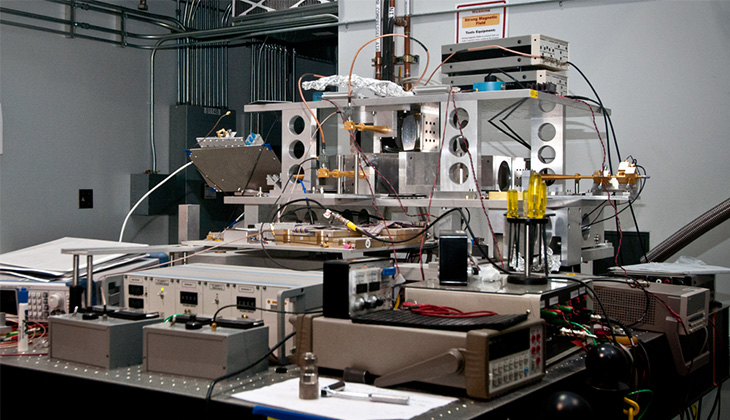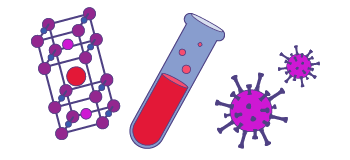
This 120-336 GHz instrument is coupled to a 12.5 tesla superconducting magnet with a homogeneity of 10-5 over a 10 mm sphere.
It consists of a multi-frequency quasi-optical millimeter-wave bridge coupled to solid state millimeter wave sources and employs fundamental Schottky-diode mixers as principal detectors.
The detection bandwidth is high and it is suitable for transient and pulsed EPR. The instrument is equipped with RF sources and amplifiers for Electron-Nuclear Double Resonance experiments to measure unresolved hyperfine interactions.
Normally the instrument is used without resonator, and allows rather large samples up to a volume of ~200 microliter. The instrument is equipped with a single axis rotator with an accuracy of the order of 0.5 degree. The maximum single crystal dimensions for the rotator are 2x2x2 mm.
In CW mode, field modulation is used. In pulsed mode, without resonator π/2 pulse lengths are of the order of 400 ns. With a Fabry-Perot resonator these pulse lengths are of the order of 100 ns.
Available frequencies are 120, 240 and 395 GHz. The sample temperature can be controlled over the range of 1.5K to 400K.
Superconducting Magnets

Explore our magnet schedule to see what exciting research is happening on our stellar fleet of instruments right now.
Takahashi, S., et al, Decoherence in crystals of quantum molecular magnets, Nature, 476 (2011) Read online.
McCamey, D.R., et al, Electronic Spin Storage in an Electrically Readable Nuclear Spin Memory with a Lifetime > 100 Seconds, Science, 330 (2010) Read online.
Morley, G.W., et al, The initialization and manipulation of quantum information stored in silicon by bismuth dopants, Nature Materials, 9 (2010) Read online.
Morley, G.W., et al, A multifrequency high-field pulsed electron paramagnetic resonance/electron-nuclear double resonance spectrometer, Rev. Sci. Instrum., 79 (2008) Read online.
Tokumoto, T., et al, Antiferromagnetic d-Electron Exchange via a Spin-Singlet pi-Electron Ground State in an Organic Conductor, Phys. Rev. Lett., 100 (2008) Read online.
Nellutla, S., et al, Electron spin relaxation and 39K pulsed ENDOR studies on Cr5+-doped K3NbO8 at 9.7 and 240 GHz, Phys. Rev. B, 78 (2008) Read online.
van Tol, J., et al, A quasioptical transient electron spin resonance spectrometer operating at 120 and 240 GHz, Rev. Sci. Instrum., 76 (2005) Read online.
Zeng, R.H., et al, Temperature dependence of the primary donor triplet state g- tensor in photosynthetic reaction centers of Rhodobacter sphaeroides R-26 observed by transient 240 GHz electron paramagnetic resonance, J. Phys. Chem. B, 107 (2003) Read online.
Last modified on 08 December 2023